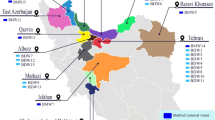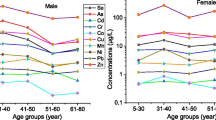Abstract
Potentially toxic elements (PTEs) are hazardous contaminants with great global environmental/ecological concerns due to their toxic, persistence, and bio-accumulative nature. This study investigates the concentrations of PTEs (Cd, Co, Cu, Fe, Ni, Mn, Pb, and Zn) in drinking water sources and consumers’ biomarkers such as hair, nails, urine, and blood. For this purpose, drinking water (n = 190) and consumer biomarker (n = 60) samples were collected from five districts of the Southern Khyber Pakhtunkhwa, Pakistan. Samples were extracted and analyzed for selected PTEs concentrations using an inductively coupled plasma mass spectrometer (ICP-MS, PerkinElmer Optima 7000 DV, USA). The concentrations of PTEs were observed within the drinking water guidelines set by the World Health Organization (WHO), except for Fe, Mn, and Pb. The determined concentrations of PTEs were used to evaluate the health risk through exposure, particularly hazard quotient (HQ) and hazard index (HI). The PTEs contamination of drinking water has led to the highest mean ADI values (39.0 and 91.8 μg/kg/day) and HQ values (0.306 and 0.130) for Zn in adults and children, respectively. The mean values of HQ and HI for selected PTEs were observed within the safe health limits (< 1). Among studied biomarkers, hair showed the highest concentrations for Mn, Zn, Cd, and Pb, plasma for Co and Cu, nails for Ni, and red blood cells (RBCs) for Fe only. This study concluded that chronic exposure of PTEs through drinking water consumption has led to their bioaccumulation in human biomarkers.


Similar content being viewed by others
References
Afridi H et al (2009) Evaluation of arsenic, cobalt, Copper and manganese in biological samples of steel mill workers by electrothermal atomic absorption spectrometry. Toxicol Ind Health 25:59–69. https://doi.org/10.1177/0748233709103036
Antoniadis V, Golia EE, Shaheen SM, Rinklebe J (2017a) Bioavailability and health risk assessment of potentially toxic elements in Thriasio plain, near Athens, Greece. Environ Geochem Health 39:319–330
Antoniadis V, Shaheen SM, Boersch J, Frohne T, Du Laing G, Rinklebe J (2017b) Bioavailability and risk assessment of potentially toxic elements in garden edible vegetables and soils around a highly contaminated former mining area in Germany. J Environ Manag 186(Part 2):192–200. https://doi.org/10.1016/j.jenvman.2016.04.036
ATSDR (2008) (Agency of Toxic substances and Disease Registry), 1999, 2007, 2008, 2012. Draft Toxicological Profile for Lead, Cadmium, Manganese and Mercury. Separate Profile Per Metal
Begum S, Shah M, Muhammad S, Khan S (2015) Role of mafic and ultramafic rocks in drinking water quality and its potential health risk assessment, northern Pakistan. J Water Health 13:1130–1142
Bermejo-Barrera P, Moreda-Pineiro A, Moreda-Pineiro J, Bermejo-Barrera A (1998) Determination of aluminium and manganese in human scalp hair by electrothermal atomic absorption spectrometry using slurry sampling. Talanta 45:1147–1154
Davis MA et al (2017) Assessment of human dietary exposure to arsenic through rice. Sci Total Environ 586:1237–1244
Dongarrà G, Lombardo M, Tamburo E, Varrica D, Cibella F, Cuttitta G (2011) Concentration and reference interval of trace elements in human hair from students living in Palermo, Sicily (Italy). Environ Toxicol Pharmacol 32:27–34
Ettinger AS et al (2017) Arsenic levels among pregnant women and newborns in Canada: results from the maternal-infant research on environmental chemicals (MIREC) cohort. Environ Res 153:8–16
Gault AG et al (2008) Arsenic in hair and nails of individuals exposed to arsenic-rich groundwaters in Kandal province, Cambodia. Sci Total Environ 393:168–176
Gil F, Hernández AF, Márquez C, Femia P, Olmedo P, López-Guarnido O, Pla A (2011) Biomonitorization of cadmium, chromium, manganese, nickel and lead in whole blood, urine, axillary hair and saliva in an occupationally exposed population. Sci Total Environ 409:1172–1180
Gul N, Shah M, Khan S, Khattak N, Muhammad S (2015) Arsenic and heavy metals contamination, risk assessment and their source in drinking water of the Mardan district, Khyber Pakhtunkhwa, Pakistan. J Water Health 13:1073–1084
Huang M, Chen X, Shao D, Zhao Y, Wang W, Wong MH (2014) Risk assessment of arsenic and other metals via atmospheric particles, and effects of atmospheric exposure and other demographic factors on their accumulations in human scalp hair in urban area of Guangzhou, China. Ecotoxicol Environ Saf 102:84–92
Ishtiaq M, Jehan N, Khan SA, Muhammad S, Saddique U, Iftikhar B, Zahidullah (2018) Potential harmful elements in coal dust and human health risk assessment near the mining areas in Cherat, Pakistan. Environ Sci Pollut Res. https://doi.org/10.1007/s11356-018-1655-5
Khan MU, Malik RN, Muhammad S (2013) Human health risk from heavy metal via food crops consumption with wastewater irrigation practices in Pakistan. Chemosphere 93:2230–2238
Khan S, Rauf R, Muhammad S, Qasim M, Din I (2016) Arsenic and heavy metals health risk assessment through drinking water consumption in the Peshawar District, Pakistan. Hum Ecol Risk Assess 22:581–596. https://doi.org/10.1080/10807039.2015.1083845
Khan SA, Khan H, Ishtiaq M, Saddique U, Muhammad S, Farooq M (2018) Shallow water proved higher levels of potentially harmful elements and human health risk along the Sadkal oil exploration and production. Desalin Water Treat https://doi.org/10.5004/dwt.2018.22385
Kidd P (2003) Colloid and clay minerals; latest nutrition fad. Total Health 19:1–41
Kippler M, Skröder H, Rahman SM, Tofail F, Vahter M (2016) Elevated childhood exposure to arsenic despite reduced drinking water concentrations—a longitudinal cohort study in rural Bangladesh. Environ Int 86:119–125
Knight C, Kaiser J, Lalor G, Robotham H, Witter J (1997) Heavy metals in surface water and stream sediments in Jamaica. Environ Geochem Health 19:63–66
Kumar M, Rahman MM, Ramanathan A, Naidu R (2016) Arsenic and other elements in drinking water and dietary components from the middle Gangetic plain of Bihar, India: health risk index. Sci Total Environ 539:125–134
Molina-Villalba I, Lacasaña M, Rodríguez-Barranco M, Hernández AF, Gonzalez-Alzaga B, Aguilar-Garduño C, Gil F (2015) Biomonitoring of arsenic, cadmium, lead, manganese and mercury in urine and hair of children living near mining and industrial areas. Chemosphere 124:83–91
Muhammad S, Shah MT, Khan S (2010) Arsenic health risk assessment in drinking water and source apportionment using multivariate statistical techniques in Kohistan region, northern Pakistan. Food Chem Toxicol 48:2855–2864
Muhammad S, Shah MT, Khan S (2011) Health risk assessment of heavy metals and their source apportionment in drinking water of Kohistan region, northern Pakistan. Microchem J 98:334–343
Omokhodion F, Crockford G (1991) Lead in sweat and its relationship to salivary and urinary levels in normal healthy subjects. Sci Total Environ 103:113–122
Rahman M et al (2015) Associations of total arsenic in drinking water, hair and nails with serum vascular endothelial growth factor in arsenic-endemic individuals in Bangladesh. Chemosphere 120:336–342
Rehman ZU, Khan S, Qin K, Brusseau ML, Shah MT, Din I (2016) Quantification of inorganic arsenic exposure and cancer risk via consumption of vegetables in southern selected districts of Pakistan. Sci Total Environ 550:321–329
Riaz A, Khan S, Muhammad S, Liu C, Shah MT, Tariq M (2018) Mercury contamination in selected foodstuffs and potential health risk assessment along the artisanal gold mining, Gilgit-Baltistan, Pakistan. Environ Geochem Health 40:625–635
Riojas-Rodríguez H, Solís-Vivanco R, Schilmann A, Montes S, Rodríguez S, Ríos C, Rodríguez-Agudelo Y (2010) Intellectual function in Mexican children living in a mining area and environmentally exposed to manganese. Environ Health Perspect 118:1465–1470
Robert G, Mari G (2003) Human health effects of metals. US Environmental Protection Agency Risk Assessment Forum, Washington
Rodríguez-Barranco M, Lacasaña M, Aguilar-Garduño C, Alguacil J, Gil F, González-Alzaga B, Rojas-García A (2013) Association of arsenic, cadmium and manganese exposure with neurodevelopment and behavioural disorders in children: a systematic review and meta-analysis. Sci Total Environ 454:562–577
Saddique U, Muhammad S, Tariq M, Zhang H, Arif M, Jadoon IA, Khattak NU (2018) Potentially toxic elements in soil of the Khyber Pakhtunkhwa province and tribal areas, Pakistan: evaluation for human and ecological risk assessment. Environ Geochem Health 1–14
Samanta G, Sharma R, Roychowdhury T, Chakraborti D (2004) Arsenic and other elements in hair, nails, and skin-scales of arsenic victims in West Bengal, India. Sci Total Environ 326:33–47. https://doi.org/10.1016/j.scitotenv.2003.12.006
Shah M, Ara J, Muhammad S, Khan S, Tariq S (2012) Health risk assessment via surface water and sub-surface water consumption in the mafic and ultramafic terrain, Mohmand agency, northern Pakistan. J Geochem Explor 118:60–67
Shakoor MB et al (2017) Human health implications, risk assessment and remediation of as-contaminated water: a critical review. Sci Total Environ 601–602:756–769. https://doi.org/10.1016/j.scitotenv.2017.05.223
Sheng J, Qiu W, Xu B, Xu H, Tang C (2016) Monitoring of heavy metal levels in the major rivers and in residents’ blood in Zhenjiang City, China, and assessment of heavy metal elimination via urine and sweat in humans. Environ Sci Pollut Res 23:11034–11045
Song Q, Li J (2015) A review on human health consequences of metals exposure to e-waste in China. Environ Pollut 196:450–461
Sukumar A, Subramanian R (2007) Relative element levels in the paired samples of scalp hair and fingernails of patients from New Delhi. Sci Total Environ 372:474–479. https://doi.org/10.1016/j.scitotenv.2006.10.020
Sun L, Wu Q, Liao K, Yu P, Cui Q, Rui Q, Wang D (2016) Contribution of heavy metals to toxicity of coal combustion related fine particulate matter (PM 2.5) in Caenorhabditis elegans with wild-type or susceptible genetic background. Chemosphere 144:2392–2400
Tripathee L, Kang S, Sharma CM, Rupakheti D, Paudyal R, Huang J, Sillanpää M (2016) Preliminary health risk assessment of potentially toxic metals in surface water of the Himalayan rivers, Nepal. Bull Environ Contam Toxicol 97:855–862
Ullah Z, Naz A, Saddique U, Khan A, Shah W, Muhammad S (2017) Potentially toxic elements concentrations and human health risk assessment of food crops in Bajaur agency, Pakistan. Environ Earth Sci 76:482
US EPA (1998) United states environmental protection agency. Integrated risk information system (IRIS)
USEPA (2005) (US Environmental Protection Agency), 2005. Guidelines for carcinogen risk assessment. Risk assessment forum, Washington, DC. EPA/630/P-03/001F
Wang T, Fu J, Wang Y, Liao C, Tao Y, Jiang G (2009) Use of scalp hair as indicator of human exposure to heavy metals in an electronic waste recycling area. Environ Pollut 157:2445–2451
Wang H, Han M, Yang S, Chen Y, Liu Q, Ke S (2011) Urinary heavy metal levels and relevant factors among people exposed to e-waste dismantling. Environ Int 37:80–85. https://doi.org/10.1016/j.envint.2010.07.005
Watanabe T et al (2000) Background lead and cadmium exposure of adult women in Xian City and two farming villages in Shaanxi Province, China. Sci Total Environ 247:1–13
WHO (2011) World Health Organization guidelines for drinking water quality, 4th edit. Recommendations, vol 1. Geneva
Wongsasuluk P, Chotpantarat S, Siriwong W, Robson M (2017) Using urine as a biomarker in human exposure risk associated with arsenic and other heavy metals contaminating drinking groundwater in intensively agricultural areas of Thailand. Environ Geochem Health 1–26
Xing R, Li Y, Zhang B, Li H, Liao X (2016) Indicative and complementary effects of human biological indicators for heavy metal exposure assessment. Environ Geochem Health 1–13
Zheng G, Xu X, Li B, Wu K, Yekeen TA, Huo X (2013) Association between lung function in school children and exposure to three transition metals from an e-waste recycling area. J Expo Sci Environ Epidemiol 23:67–72
Funding
Financial support was provided by the Higher Education Commission (HEC), Islamabad, Pakistan, technical support of University of Peshawar, Pakistan, Institute of Urban Environment, Chinese Academy of Sciences and anonymous reviewers for their time and inputs for quality improvement of this manuscript.
Author information
Authors and Affiliations
Corresponding authors
Ethics declarations
Conflict of interest
The authors declare that they have no conflicts of interest.
Additional information
Responsible editor: Philippe Garrigues
Rights and permissions
About this article
Cite this article
Rehman, U.u., Khan, S. & Muhammad, S. Associations of potentially toxic elements (PTEs) in drinking water and human biomarkers: a case study from five districts of Pakistan. Environ Sci Pollut Res 25, 27912–27923 (2018). https://doi.org/10.1007/s11356-018-2755-y
Received:
Accepted:
Published:
Issue Date:
DOI: https://doi.org/10.1007/s11356-018-2755-y




